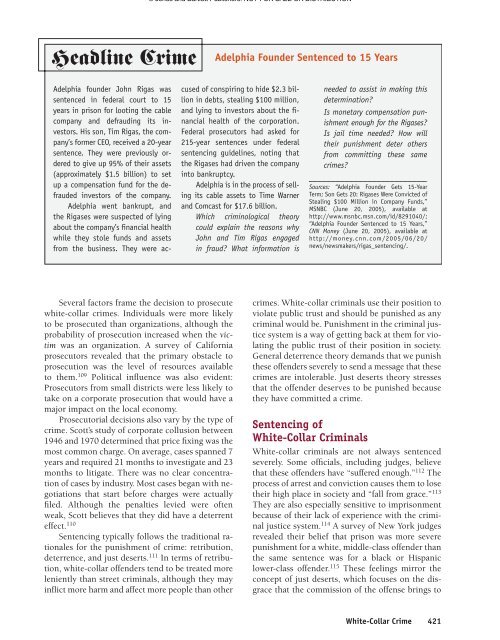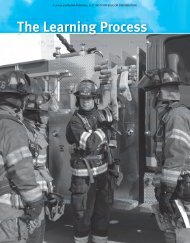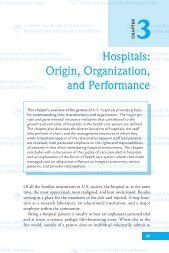CHAPTER - Jones & Bartlett Learning
CHAPTER - Jones & Bartlett Learning
CHAPTER - Jones & Bartlett Learning
You also want an ePaper? Increase the reach of your titles
YUMPU automatically turns print PDFs into web optimized ePapers that Google loves.
30017_CH15_398_431_r7.qxp 4/7/06 3:13 PM Page 421<br />
© <strong>Jones</strong> and <strong>Bartlett</strong> Publishers. NOT FOR SALE OR DISTRIBUTION<br />
Headline Crime<br />
Several factors frame the decision to prosecute<br />
white-collar crimes. Individuals were more likely<br />
to be prosecuted than organizations, although the<br />
probability of prosecution increased when the victim<br />
was an organization. A survey of California<br />
prosecutors revealed that the primary obstacle to<br />
prosecution was the level of resources available<br />
to them. 109 Political influence was also evident:<br />
Prosecutors from small districts were less likely to<br />
take on a corporate prosecution that would have a<br />
major impact on the local economy.<br />
Prosecutorial decisions also vary by the type of<br />
crime. Scott’s study of corporate collusion between<br />
1946 and 1970 determined that price fixing was the<br />
most common charge. On average, cases spanned 7<br />
years and required 21 months to investigate and 23<br />
months to litigate. There was no clear concentration<br />
of cases by industry. Most cases began with negotiations<br />
that start before charges were actually<br />
filed. Although the penalties levied were often<br />
weak, Scott believes that they did have a deterrent<br />
effect. 110<br />
Sentencing typically follows the traditional rationales<br />
for the punishment of crime: retribution,<br />
deterrence, and just deserts. 111 In terms of retribution,<br />
white-collar offenders tend to be treated more<br />
leniently than street criminals, although they may<br />
inflict more harm and affect more people than other<br />
Adelphia Founder Sentenced to 15 Years<br />
Adelphia founder John Rigas was<br />
sentenced in federal court to 15<br />
years in prison for looting the cable<br />
company and defrauding its investors.<br />
His son, Tim Rigas, the company’s<br />
former CEO, received a 20-year<br />
sentence. They were previously ordered<br />
to give up 95% of their assets<br />
(approximately $1.5 billion) to set<br />
up a compensation fund for the defrauded<br />
investors of the company.<br />
Adelphia went bankrupt, and<br />
the Rigases were suspected of lying<br />
about the company’s financial health<br />
while they stole funds and assets<br />
from the business. They were accused<br />
of conspiring to hide $2.3 billion<br />
in debts, stealing $100 million,<br />
and lying to investors about the financial<br />
health of the corporation.<br />
Federal prosecutors had asked for<br />
215-year sentences under federal<br />
sentencing guidelines, noting that<br />
the Rigases had driven the company<br />
into bankruptcy.<br />
Adelphia is in the process of selling<br />
its cable assets to Time Warner<br />
and Comcast for $17.6 billion.<br />
Which criminological theory<br />
could explain the reasons why<br />
John and Tim Rigas engaged<br />
in fraud? What information is<br />
needed to assist in making this<br />
determination?<br />
Is monetary compensation punishment<br />
enough for the Rigases?<br />
Is jail time needed? How will<br />
their punishment deter others<br />
from committing these same<br />
crimes?<br />
Sources: “Adelphia Founder Gets 15-Year<br />
Term; Son Gets 20: Rigases Were Convicted of<br />
Stealing $100 Million in Company Funds,”<br />
MSNBC (June 20, 2005), available at<br />
http://www.msnbc.msn.com/id/8291040/;<br />
“Adelphia Founder Sentenced to 15 Years,”<br />
CNN Money (June 20, 2005), available at<br />
http://money.cnn.com/2005/06/20/<br />
news/newsmakers/rigas_sentencing/.<br />
crimes. White-collar criminals use their position to<br />
violate public trust and should be punished as any<br />
criminal would be. Punishment in the criminal justice<br />
system is a way of getting back at them for violating<br />
the public trust of their position in society.<br />
General deterrence theory demands that we punish<br />
these offenders severely to send a message that these<br />
crimes are intolerable. Just deserts theory stresses<br />
that the offender deserves to be punished because<br />
they have committed a crime.<br />
Sentencing of<br />
White-Collar Criminals<br />
White-collar criminals are not always sentenced<br />
severely. Some officials, including judges, believe<br />
that these offenders have “suffered enough.” 112 The<br />
process of arrest and conviction causes them to lose<br />
their high place in society and “fall from grace.” 113<br />
They are also especially sensitive to imprisonment<br />
because of their lack of experience with the criminal<br />
justice system. 114 A survey of New York judges<br />
revealed their belief that prison was more severe<br />
punishment for a white, middle-class offender than<br />
the same sentence was for a black or Hispanic<br />
lower-class offender. 115 These feelings mirror the<br />
concept of just deserts, which focuses on the disgrace<br />
that the commission of the offense brings to<br />
1<br />
2<br />
3<br />
4<br />
5<br />
6<br />
7<br />
8<br />
9<br />
10<br />
11<br />
12<br />
13<br />
14<br />
15<br />
16<br />
17<br />
18<br />
19<br />
20<br />
21<br />
22<br />
23<br />
24<br />
25<br />
26<br />
27<br />
28<br />
29<br />
30<br />
31<br />
32<br />
33<br />
34<br />
35<br />
36<br />
37<br />
38<br />
39<br />
40<br />
41<br />
42<br />
43<br />
44<br />
45<br />
46<br />
47<br />
48<br />
49<br />
50<br />
51<br />
52<br />
White-Collar Crime 421<br />
1st pass Pages

















